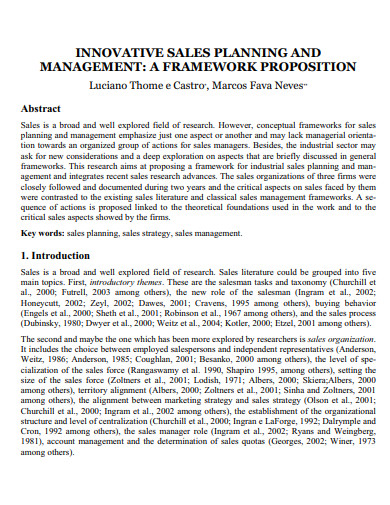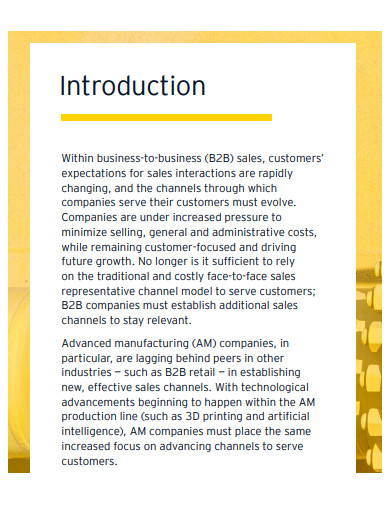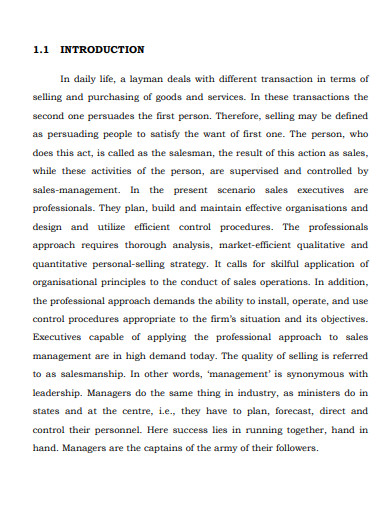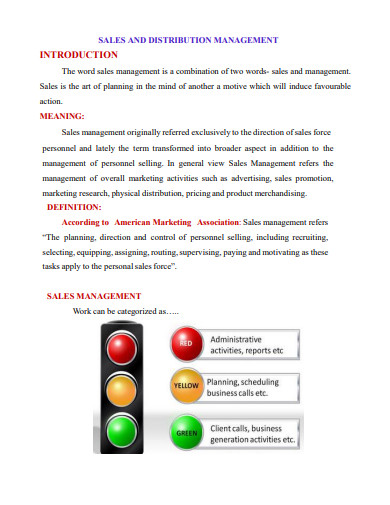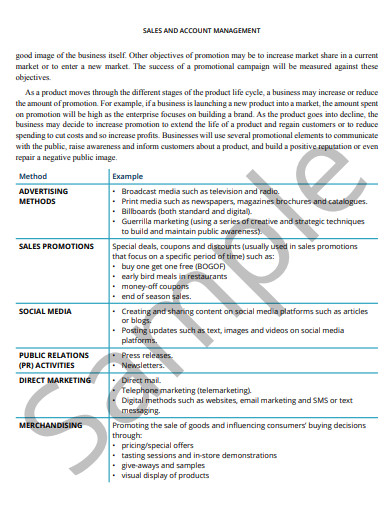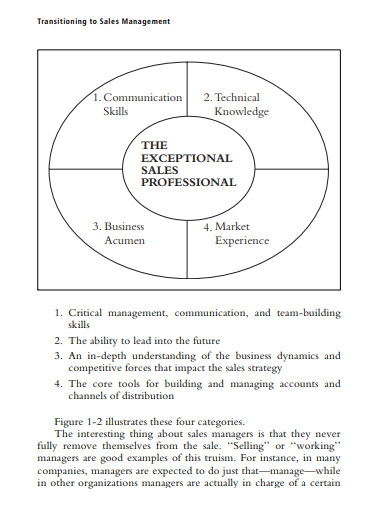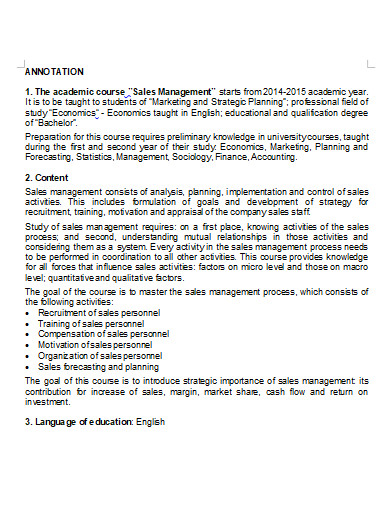Businesses that succeed excel at one thing: sales management. Your sales department’s success or failure hinges on the quality of your sales manager. Because a business has so many moving elements, the sales management process must be well understood to ensure that each “aspect” of the overall sales effort is running smoothly. Sales managers‘ primary goal should be to maximize profit for the company while providing the best possible value to customers. Who doesn’t appreciate a win-win situation? It’s all about sales in any firm. The basic purpose of any business, whether B2B or B2C, is to generate income. Only a steady approach combined with a well-defined sales strategy may ensure a positive outcome.
10+ Sales Management Plan Samples
What is sales management? Sales management is the act of establishing a sales staff, coordinating sales operations, and executing sales techniques that enable a company to consistently meet, if not exceed its sales goals. A sales management strategy is a necessity if your company generates any money at all. When it comes to increasing sales performance for any size business, regardless of industry, the key to success is always accurate sales management systems, which begin with a strong sales manager who knows how to inspire and lead a sales team.
1. Sales Management Plan

2. 90 Days Sales Management Plan

3. 30 60 90 Day Sales Management Plan

4. Innovative Sales Management Plan
5. Sample Sales Management Plan
6. Simple Sales Management Plan
7. Sales Management Plan Example
8. Sales and Distribution Management Plan
9. Sales and Account Management Plan
10. Formal Sales Management Plan
11. Printable Sales Management Plan
The sales management process not only assists your firm in meeting its sales goals but also allows you to stay in touch with your industry as it evolves, which can mean the difference between surviving and flourishing in an increasingly competitive market. With the following sales management advice, whether you’re an experienced or novice sales manager, you should be able to review and obtain visibility into your present sales staff.
You’ll be better equipped to detect issues early on, coach employees before it’s too late, and have a better understanding of the tasks the team should be doing to enhance sales after you have a clear idea of what processes to monitor and how to keep track of them.
Structure of a Sales Management Plan
- Executive summary – The executive summary is similar to establishing the foundation bricks for your company. The vision and objective of your organization should be stated. What is your ultimate sales objective? Include information on your firm’s origin story, how you got to where you are now, and where you expect the company to be in X years in your executive summary.
- Business goals and revenue targets – You can create a revenue- or volume-based goal, such as a target of $100 million in annual recurring revenue, extending your product portfolio, or growing your client base. Maintain a realistic income or volume objective; only then will your sales plan be successful.
- Performance analysis – Give your sales staff some context on last year’s performance so they can see where they are now and what has to be done differently to go to where you want to go.
- Industry and market overview – Understanding your market position requires competitor analysis, SWOT analysis, industry trend studies, and market research. Having a sharp eye for this in your sales planning aids in the creation of a better sales plan.
- Strategies – The following methods should be included in your sales management strategy:
– Introduce aggressive sales tactics.
– Explore new markets.
– Provide substantial savings.
– Customers should be retargeted.
– Existing consumers can be cross-sold products. - Segments – Your entire sales staff should always be clear about who they’re selling to. The target demographic, target industries, and ideal client profiles that your firm caters to with its products and services should all be included in your sales plan.
- Resources – How can you grow your sales team to reach sales targets and achieve the sales plan if your sales team is small? The sales strategy should also incorporate hiring advice. If your outbound sales force is overworked, your sales plan should specify how many resources are needed over a specific time period, as well as a solid outbound hiring strategy.
- Detailed plan – Ensure unambiguous distribution of duties and responsibilities, as well as easy handoffs and communication at each stage. A CRM can help all team members gain visibility into the sales pipeline and process.
- Budget – Ensure clear assignment of jobs and responsibilities, as well as smooth handoffs and communication at every stage. A CRM can provide visibility into the sales pipeline and process to all members of the team.
FAQs
What are the steps in creating a sales plan?
You should state your mission, set objectives, describe a team, define a target market, evaluate the resources, make a comparative analysis, set a budget, define marketing strategy, work out the strategy, and define an action plan.
What do you mean by sales?
There are numerous definitions of sales, but in essence, you’re facilitating a transaction between your firm and its clients, guiding them through a process that leads to a purchase. Every business has a sales cycle, which is a set of activities that assist a company’s product reach its intended audience. As a result, establishing a sales pipeline, also known as a sales funnel, will make it easier to move these deals forward.
There is no single strategy that will completely fit your firm. There will be roadblocks along the way, but you can always change the form of your sales strategy until you get positive results. Take your time identifying possibilities and solutions to problems.
Related Posts
FREE 10+ Sprint Planning Samples In MS Word | Google Docs | PDF
FREE 10+ Wedding Planning Samples in MS Word | Apple Pages | Powerpoint | PDF
FREE 9+ Monthly Study Planner Samples in PSD | Illustrator | InDesign | PDF
FREE 9+ Sample Curriculum Planning Templates in PDF | MS Word
FREE 10+ Teacher Development Plan Samples in MS Word | Google Docs | Apple Pages | PDF
FREE 10+ Basketball Practice Plan Samples in PDF
FREE 12+ School Business Plan Samples in PDF | MS Word | Apple Pages | Google Docs
FREE 7+ Client Strategic Plan Samples in PDF | MS Word
FREE 11+ Trucking Business Plan Templates in PDF | MS Word | Google Docs | Pages
FREE 7+ Small Hotel Business Plan Samples PDF | MS Word | Apple Pages | Google Docs
FREE 14+ Bakery Business Plans in MS Word | PDF | Google Docs | Pages
FREE 4+ Yearly Lesson Plan Samples in PDF
FREE 50+ Strategic Planning Samples in Google Docs | Pages | PDF | MS Word
FREE 10+ Construction Project Plan Samples in MS Word | Google Docs | Apple Pages | PDF
FREE 10+ Construction Marketing Business Plan Samples in MS Word | Google Docs | PDF

